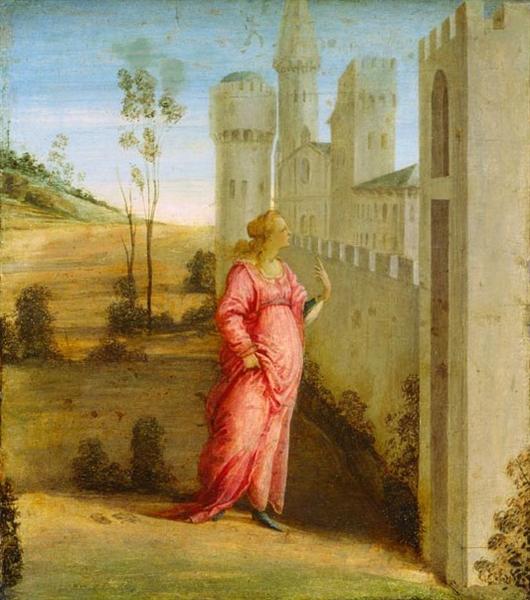Description
Sandro Botticelli's painting "Workshop of Esther at the Palace Gate" (1480) is a work that encapsulates both the artist's technical mastery and the rich narrative charge associated with its subject matter. Botticelli, a leading exponent of the Italian Renaissance, is known for his distinctive style that fuses elements of elegance, sensuality and a deep spirituality. In this work, the artist presents a scene that illustrates a crucial moment in the biblical story of Esther, the Jewish queen who risks her life to save her people from the Persian threat.
The painting's composition is rich in detail and defined by a skillful use of perspective, which guides the viewer's eye into the heart of the action. In the center, Esther stands out as the main figure, dressed in elaborate attire that reflects her royal status. The folds of her cloak are painted with meticulous attention, highlighting Botticelli's ability to capture texture and movement. The way Esther's figure stands at the palace gate, surrounded by an architectural setting that suggests majestic grandeur, emphasizes her role as a figure of power and decision.
The colours used in the work are particularly interesting. Botticelli employs a palette of warm and vibrant tones, with predominance of reds, golds and blues that not only beautify the scene, but also bring a sense of life and energy to the visual narrative. The characteristically "Botticelian" luminescence gives the colours an almost ethereal glow, suggesting divinity and the importance of the message being conveyed.
As for the characters in the play, while Esther is the central figure, no less relevant are the faces that surround her. The characters' expressions, whimsically varied, lend an emotional charge to the narrative. Some look at her with admiration, others with intrigue, which provokes a series of interpretations about the complex relationship between power, community and individuality in a social continent full of tensions and challenges.
Looking at the broader context of the Renaissance, "Workshop of Esther at the Palace Gate" can be placed within a series of works that address themes of heroism and virtue, something that was in tune with Renaissance ideals. Botticelli, in his effort to combine biblical narrative with an aesthetically appealing style, opens a dialogue about morality and civic conscience, the role of women in society, and divine intervention in human affairs.
Contemporary paintings to this work or even in his own corpus, such as "The Birth of Venus" or "Spring", show that fusion of beauty and narrative that characterizes his style. Moreover, the use of symbolic representation and allegory is not only an aesthetic resource, but also a means to convey a deeper message, in this case, the value of personal sacrifice and providential intervention.
In short, “Esther’s Workshop at the Palace Gate” is a work that not only graces a museum wall, but also invites deeper reflection on the human condition and the ethical dilemmas faced in times of crisis. Botticelli’s vision unfolds in an amalgam of color, form, and meaning that resonates with powerful forces, making this painting an enduring testament to the Renaissance genius and its impact on art history.
KUADROS ©, a famous painting on your wall.
Hand-made oil painting reproductions, with the quality of professional artists and the distinctive seal of KUADROS ©.
Painting reproduction service with satisfaction guarantee. If you are not completely satisfied with the replica of your painting, we will refund 100% of your money.

